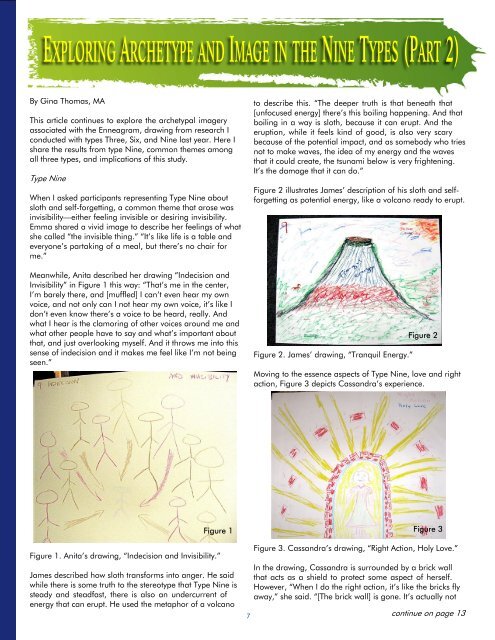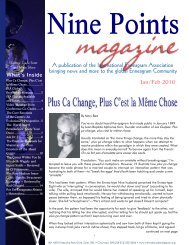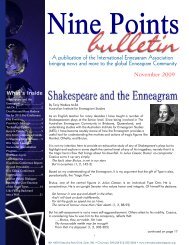Nine Points Magazine - International Enneagram Association
Nine Points Magazine - International Enneagram Association
Nine Points Magazine - International Enneagram Association
You also want an ePaper? Increase the reach of your titles
YUMPU automatically turns print PDFs into web optimized ePapers that Google loves.
By Gina Thomas, MA<br />
This article continues to explore the archetypal imagery<br />
associated with the <strong>Enneagram</strong>, drawing from research I<br />
conducted with types Three, Six, and <strong>Nine</strong> last year. Here I<br />
share the results from type <strong>Nine</strong>, common themes among<br />
all three types, and implications of this study.<br />
When I asked participants representing Type <strong>Nine</strong> about<br />
sloth and self-forgetting, a common theme that arose was<br />
invisibility—either feeling invisible or desiring invisibility.<br />
Emma shared a vivid image to describe her feelings of what<br />
she called “the invisible thing.” “It’s like life is a table and<br />
everyone’s partaking of a meal, but there’s no chair for<br />
me.”<br />
Meanwhile, Anita described her drawing “Indecision and<br />
Invisibility” in Figure 1 this way: “That’s me in the center,<br />
I’m barely there, and [muffled] I can’t even hear my own<br />
voice, and not only can I not hear my own voice, it’s like I<br />
don’t even know there’s a voice to be heard, really. And<br />
what I hear is the clamoring of other voices around me and<br />
what other people have to say and what’s important about<br />
that, and just overlooking myself. And it throws me into this<br />
sense of indecision and it makes me feel like I’m not being<br />
seen.”<br />
Figure 1. Anita’s drawing, “Indecision and Invisibility.”<br />
James described how sloth transforms into anger. He said<br />
while there is some truth to the stereotype that Type <strong>Nine</strong> is<br />
steady and steadfast, there is also an undercurrent of<br />
energy that can erupt. He used the metaphor of a volcano<br />
7<br />
to describe this. “The deeper truth is that beneath that<br />
[unfocused energy] there’s this boiling happening. And that<br />
boiling in a way is sloth, because it can erupt. And the<br />
eruption, while it feels kind of good, is also very scary<br />
because of the potential impact, and as somebody who tries<br />
not to make waves, the idea of my energy and the waves<br />
that it could create, the tsunami below is very frightening.<br />
It’s the damage that it can do.”<br />
Figure 2 illustrates James’ description of his sloth and selfforgetting<br />
as potential energy, like a volcano ready to erupt.<br />
Figure 2. James’ drawing, “Tranquil Energy.”<br />
Moving to the essence aspects of Type <strong>Nine</strong>, love and right<br />
action, Figure 3 depicts Cassandra’s experience.<br />
Figure 3. Cassandra’s drawing, “Right Action, Holy Love.”<br />
In the drawing, Cassandra is surrounded by a brick wall<br />
that acts as a shield to protect some aspect of herself.<br />
However, “When I do the right action, it’s like the bricks fly<br />
away,” she said. “[The brick wall] is gone. It’s actually not





